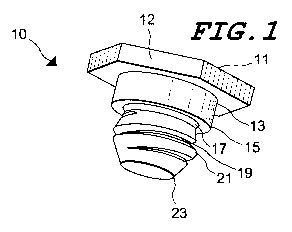Some of the information on this Web page has been provided by external sources. The Government of Canada is not responsible for the accuracy, reliability or currency of the information supplied by external sources. Users wishing to rely upon this information should consult directly with the source of the information. Content provided by external sources is not subject to official languages, privacy and accessibility requirements.
Any discrepancies in the text and image of the Claims and Abstract are due to differing posting times. Text of the Claims and Abstract are posted:
| (12) Patent Application: | (11) CA 2879801 |
|---|---|
| (54) English Title: | TACK SCREW |
| (54) French Title: | PUNAISE |
| Status: | Deemed Abandoned and Beyond the Period of Reinstatement - Pending Response to Notice of Disregarded Communication |
| (51) International Patent Classification (IPC): |
|
|---|---|
| (72) Inventors : |
|
| (73) Owners : |
|
| (71) Applicants : |
|
| (74) Agent: | SMART & BIGGAR LP |
| (74) Associate agent: | |
| (45) Issued: | |
| (86) PCT Filing Date: | 2013-07-09 |
| (87) Open to Public Inspection: | 2014-01-23 |
| Availability of licence: | N/A |
| Dedicated to the Public: | N/A |
| (25) Language of filing: | English |
| Patent Cooperation Treaty (PCT): | Yes |
|---|---|
| (86) PCT Filing Number: | PCT/US2013/049639 |
| (87) International Publication Number: | WO 2014014699 |
| (85) National Entry: | 2015-01-21 |
| (30) Application Priority Data: | ||||||
|---|---|---|---|---|---|---|
|
The present clinch screw can be secured through a hole in a sheet of metal by a simple press-in application like a tack pin. An undercut clinch feature on the screw shank just underneath the head and above a threaded bulb portion of the shank secures the screw to the sheet as material from the sheet cold-flows into the undercut. Simultaneously, sheet material also flows around and between the bulb threads which forms partial female threads in the sidewall of the sheet hole and provides added pull-out resistance. The screw can then be simply turned out to remove it. In doing so additional female threads are cut into the upper portion of the hole sidewall as the threaded bulb moves upward and then out of the hole. A re-useable threaded hole in the sheet is left behind.
L'invention porte sur une vis de sertissage, laquelle vis peut être fixée à travers un trou dans une feuille de métal par une simple application par pression, comme une punaise. Un élément de sertissage entaillé sur la tige de vis juste en dessous de la tête et au-dessus d'une partie de bulbe filetée de la tige fixe la vis à la feuille lorsqu'un matériau à partir de la feuille s'écoule à froid dans l'entaille. Simultanément, un matériau en feuille s'écoule également autour des filetages du bulbe et entre ceux-ci, ce qui forme des filetages femelle partiels dans la paroi latérale du trou de feuille et ce qui produit une résistance à l'arrachage supplémentaire. La vis peut ensuite être simplement tournée vers l'extérieur pour retirer celle-ci. Ce faisant, des filetages femelle additionnels sont découpés dans la partie supérieure de la paroi latérale de trou lorsque le bulbe fileté se déplace vers le haut, puis hors du trou. Un trou fileté réutilisable dans la feuille demeure.
Note: Claims are shown in the official language in which they were submitted.
Note: Descriptions are shown in the official language in which they were submitted.

2024-08-01:As part of the Next Generation Patents (NGP) transition, the Canadian Patents Database (CPD) now contains a more detailed Event History, which replicates the Event Log of our new back-office solution.
Please note that "Inactive:" events refers to events no longer in use in our new back-office solution.
For a clearer understanding of the status of the application/patent presented on this page, the site Disclaimer , as well as the definitions for Patent , Event History , Maintenance Fee and Payment History should be consulted.
| Description | Date |
|---|---|
| Application Not Reinstated by Deadline | 2016-07-11 |
| Time Limit for Reversal Expired | 2016-07-11 |
| Deemed Abandoned - Failure to Respond to Maintenance Fee Notice | 2015-07-09 |
| Inactive: Cover page published | 2015-03-03 |
| Inactive: Notice - National entry - No RFE | 2015-01-29 |
| Application Received - PCT | 2015-01-29 |
| Inactive: First IPC assigned | 2015-01-29 |
| Inactive: IPC assigned | 2015-01-29 |
| National Entry Requirements Determined Compliant | 2015-01-21 |
| Application Published (Open to Public Inspection) | 2014-01-23 |
| Abandonment Date | Reason | Reinstatement Date |
|---|---|---|
| 2015-07-09 |
| Fee Type | Anniversary Year | Due Date | Paid Date |
|---|---|---|---|
| Reinstatement (national entry) | 2015-01-21 | ||
| Basic national fee - standard | 2015-01-21 |
Note: Records showing the ownership history in alphabetical order.
| Current Owners on Record |
|---|
| PEM MANAGEMENT, INC. |
| Past Owners on Record |
|---|
| MICHAEL MALONEY |